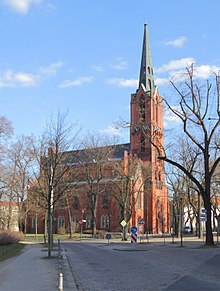Saint Gertraud Church (Frankfurt (Oder))
| St. Gertraud Church | |
|---|---|

|
|
| address | Frankfurt (Oder), |
| Denomination | evangelical |
| local community | St. Gertraud and St. Marien |
| Current usage | Parish church |
| building | |
| Year of construction (s) | 1873-1878; 1945/49 repairs |
| style | Neo-Gothic |
The St. Gertraud Church is a Protestant church in the city of Frankfurt (Oder) . It is under the patronage of Saint Gertrude of Nivelles .
history
Precursors
In 1368, the St. Gertraud, Urban and Theobald chapel in front of the Guben Gate was first mentioned as a place of prayer by the dressmakers' guild for the residents of the Guben suburbs in Frankfurt and the merchants moving south . The chapel and its successors were roughly where the Heinrich von Kleist memorial stands today.
When the Guben suburb was destroyed by the Hussites in 1432, the chapel was also destroyed, but was soon rebuilt. As a result of the Reformation , the chapel was elevated to a parish church in 1539 . A church register has been kept since 1614 .
In April 1631, shortly before the troops of the Swedish King Gustav II Adolf attacked in the Thirty Years' War , the imperial troops burned the Guben suburb and the church. 1660, some thirty years later, she was in the Baroque rebuilt style on April 25, 1662 consecrated . In 1670 the late Gothic altar shrine was built .
After the Wars of Liberation in 1820, the dressmaking guild could no longer finance the maintenance of the church, so that the building was transferred to the city of Frankfurt (Oder). Before the dressmaker's guild was dissolved, they donated a silver baptismal bowl , baptismal jug and a baptismal table . The baptismal bowl is still in use today.
In 1822 the church was dilapidated; Services until the renovation in 1823 took place in the Marienkirche . In 1856 the interior was restored, during which the Marienkirche was used again.
Today's church is being built
In 1865 the magistrate set up a commission for a new building in St. Gertraud. After purchasing land and looking for an architect, a new building in the neo-Gothic style was begun in 1873 with a loan . The architects Carl Christ and Wilhelm Kinzel designed the three-aisled, neo-Gothic basilica. On December 20, 1878, construction was completed and the new church was consecrated. 1,000 invitations were sent to the inauguration service. The event was significant as it was the first new church in Frankfurt since the Middle Ages. The community celebrated the inauguration later. In 1879 the organ was finished.
Around 1882/1885 St. Gertraud received a new spire. Around 1930 repairs were carried out again, as a result of which various ornaments were removed. The tower got its top in its present form.
At the end of the Second World War , the church was badly damaged by artillery hits, but it was quickly repaired. On May 15, 1949, the provisionally renovated church was used again.
In 1975 the Gertraud and Marien parishes were united. During the renovation between 1978 and 1980 in St. Gertraud, a false ceiling was installed at the level of the former galleries. On the lower floor, community and office rooms were created, and a church room on the upper floor. The rectory of the Mariengemeinde was to be converted into a school.
After 1980, the medieval art objects high altar, bronze baptism, a seven-flame chandelier and many epitaphs from St. Mary's Church were brought into the upper part of the church.
Candelabra
The medieval bronze chandelier from around 1375 is over four meters high and wide. It is one of the largest medieval candlesticks and has been in the church since 1981. During the Thirty Years' War the candlestick was sunk in the Oder to save it from the Swedes.
organ
Between 1878 and 1879, the Wilhelm Sauer company built today's three-manual organ with a pedal with 36 stops . The pipes stand on mechanical cone chests . The romantic instrument has the following disposition :
|
|
|
|
||||||||||||||||||||||||||||||||||||||||||||||||||||||||||||||||||||||||||||||||||||||||||||||||||||||||||||||||||||||||
- Coupling : II / I, III / I, I / P, II / P
- Playing aids : Tutti I Manual, Tutti II Manual, Tutti III Manual, Tutti Pedal, Crescendo roller
Web links
Individual evidence
- ↑ a b Lisa Mahlke: St. Gertraud Church celebrates its birthday. In: moz.de. December 21, 2018, accessed January 4, 2019 .
- ↑ Märkische Oderzeitung Siebenflammige Prophezeiung, accessed on March 6, 2014
- ↑ Information and a photo of the organ on the organ database
Coordinates: 52 ° 20 ′ 19 ″ N , 14 ° 33 ′ 11.3 ″ E




